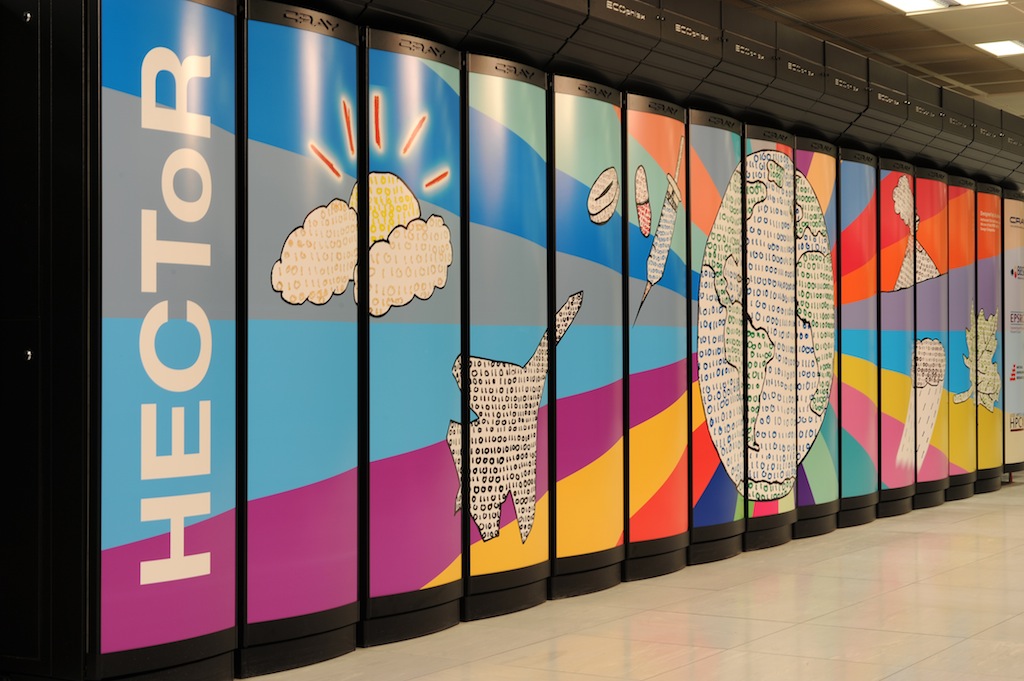Minister launches next generation of supercomputers for UK researchers
Imagine if every person on the planet were able to carry out 250,000 calculations per second simultaneously. This is the combined capability of the next stage of development, announced today, of two giant computers, HECToR and BlueGene/Q, based at the University of Edinburgh's Advanced Computing Facility (ACF). It marks the next chapter in the UK's supercomputing programme.
The computers can deliver complex computer simulations across a range of scientific disciplines and are funded by four of the UK Research Councils, EPSRC, STFC, NERC and BBSRC. Their increased computing capacity and performance will help UK researchers' work in forecasting the impact of climate change, the fundamental structure of matter, fluctuations in ocean currents, projecting the spread of epidemics, designing new materials, the structure and evolution of the universe and developing new medicinal drugs.
Launching the new phases at an event jointly hosted by the University of Edinburgh and the UK Research Councils, Minister for Universities and Science, David Willetts, said:
"E-infrastructure is fundamental to modern research and development. It helps our world-leading science base achieve breakthroughs across a range of important disciplines and helps industry design and manufacture new products.
"These impressive new supercomputers will drive growth and innovation. They will provide UK businesses and researchers with the technology they need to compete successfully on a global scale."
Mr Willetts also presented a plaque to the winner of a schools art competition to produce a design for the front panels of the HECToR computer.
Professor Sir Timothy O'Shea, Principal of the University of Edinburgh, said:
"We are delighted to host the next generation in supercomputing capability for researchers across the UK. HECToR and BlueGene/Q will each play a significant role in facilitating ground-breaking research across many areas of science, with tremendous benefits for society. We look forward to working with our partner organisations in delivering this computing capability and to seeing the contribution it will make."
Commenting on HECToR Phase 3, which has been funded by a £13.9 million grant from the Engineering and Physical Sciences Research Council (EPSRC), which manages the service, Professor David Delpy, Chief Executive, said:
"High Performance Computing is vital to supporting the development of science, discovery and new commercial partnerships. As HPC becomes more powerful, and it is possible to model more complex problems in greater detail, the types of simulation that HECToR is capable of become an increasingly valuable tool."
Professor John Womersley, Chief Executive Officer of STFC said:
"Supercomputers are the essential, behind-the-scenes tools that enable modern science. Whether you are analysing climate data from a satellite, designing a new medicine or looking for the Higgs boson, access to high performance computers is vital. These new computers will undoubtedly facilitate breakthroughs across the scientific disciplines, and lead to additional economic and societal benefits for the UK."
Also announced at the launch was the winner of a schools art competition to design a pictorial representation of the work carried out by HECToR. The winning picture has been placed on the front panels of the computer.
The winner, sixteen-year-old Lily Johnson, from Hethersett Old Hall School near Norwich, said:
"I entered the HECToR design competition at the suggestion of my chemistry teacher, Miss Mann. After reading about the capabilities of the supercomputer I wanted to represent these in my design.
"The rain, cloud and sun represent mapping weather patterns and climate change, the volcano the prediction of natural disasters, the syringe and tablets the computer's application in medical advances, the leaf the advancing of understanding complex biological systems and the aeroplane the computer's role in improving engineering of aircraft.
"I put these around a globe as the work of the computer has global benefits. All the pictures are coloured in binary code to show how the technology links them all together.
"I am very honoured that my design has been chosen for the computer, as its work will be influential in so many fields. It is an amazing next technological step in the important issues affecting our lives, such as climate change."
Both the BlueGene/Q and HECToR facilities have approximately the same computational performance, 800 Teraflops (800 million million million million). HECToR has a memory of 90 Terabytes - equivalent to that of over 180,000 iPhones. It also has one Petabyte of disk space for storing data. If your iPhone had that much space it could hold 200 million tracks, and if you started listening to each one of them in 2012, you would still be listening in 3153.
The BlueGene/Q design achieves a very high concentration of computing power in a small space and is the most energy efficient supercomputer ever built. Using just the electricity it takes to power a light bulb it can perform the calculations of 100 laptops.
You can view the launch movie at
Why is HECToR Important? and view pictures
of the launch event at the HECToR Gallery.
![]()
